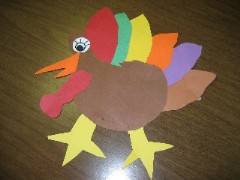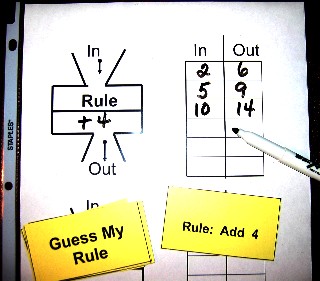Students in Mrs. Bestle's class in Keansburg, NJ, created turkey glyphs that tell a story about how they celebrate Thanksgiving and what foods they like to eat on that special day. It's great to have students create the legend(key) for what different parts of the turkey glyph mean (e.g. like white or dark meat, eat home or away, like gravy, feather colors for different vegetables, etc.)
Glyphs are a great visual display of data and may be used to create a seasonal bulletin board of student work. Be sure to use the display for some data analysis activities.
- Will more people in this class eat at home or away for Thanksgiving?
- Do more people in this class like corn or potatoes
- How many people in this class like yams?
 Developing the legend(key) with students allows teachers to customize the activity to fit individual classes. Creating a legend for a glyph is a higher-order thinking skill that develops critical thinking skills.
Developing the legend(key) with students allows teachers to customize the activity to fit individual classes. Creating a legend for a glyph is a higher-order thinking skill that develops critical thinking skills.
See turkey glyph for one teacher's legend and lesson plan for this activity.
This function machine game was created to give students practice in saying and writing the rule, given an input/output table. One student has the rule which the other student has to guess. The guesser records an input number in the table. The rule person must apply the rule and tell the output number. Student pairs repeat this until the guesser correctly identifies the rule by saying and writing it. Students then switch places and repeat the activity.
Download three different levels of rules for play: simple addition & subtraction, multiplication or two-step rules.
Differentiation: This game is easily differentiated by varying the rule cards provided to students. Use simple one-step addition and/or subtraction for basic skills students and challenge better students by graduating them to 2-step rules. Consider printing the different level rules on different color paper so that students may easily select the proper level from the math center.
Enrichment: Provide blank cards for students to create their own rules to challenge their peers. Be sure that students try their rule on at least 3 other students to be sure that they have written it correctly.
Introduce elementary students to the concept of functions by investigating growing patterns. Visual patterns formed with manipulatives are especially effective for elementary students and allow them to concretely build understanding as they first reproduce, then extend the pattern to the next couple of stages. Finally, students explain the pattern in words and try to write a rule that works for any stage.
See Mathwire's Investigating Growing Patterns for specific suggestions on using these patterns to help elementary students develop a concept of functions. The article includes activities with handouts that teachers can use to introduce this topic to elementary students. A Function Scrapbook of function ideas is included and examples of function problems created by elementary students will be added as they are completed. Literature connections and web links to relevant sites on the internet are also included in the article.
 Developing the legend(key) with students allows teachers to customize the activity to fit individual classes. Creating a legend for a glyph is a higher-order thinking skill that develops critical thinking skills.
Developing the legend(key) with students allows teachers to customize the activity to fit individual classes. Creating a legend for a glyph is a higher-order thinking skill that develops critical thinking skills. 




